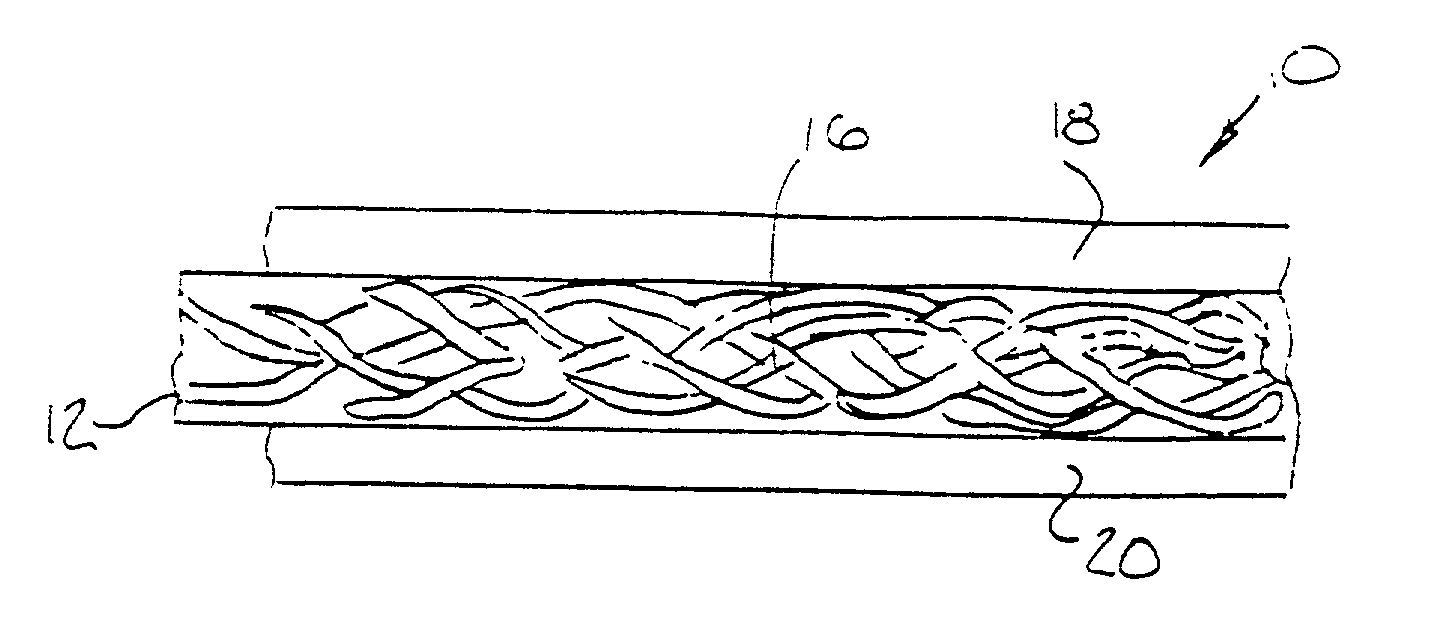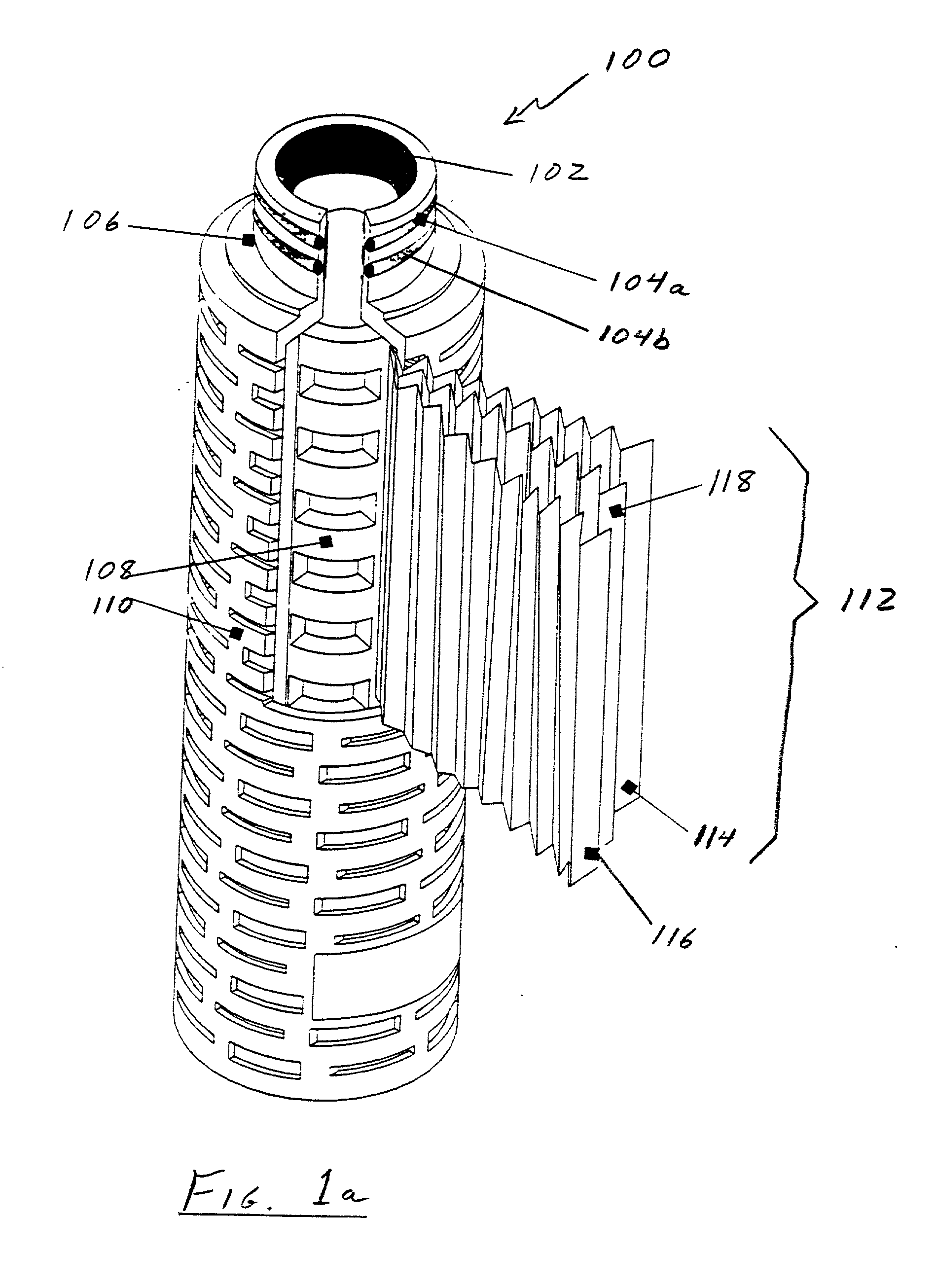Filter cartridge having high area microporous membrane
a filter cartridge and microporous membrane technology, applied in the direction of membranes, filtration separation, separation processes, etc., can solve the problems of limiting the thickness of the support layer of the reinforced membrane and the non-reinforced qualifying layer, the utility of the laminated composite membrane is generally limited to sterilizing applications, and the relative complexity and cost of production are significant problems, so as to achieve the effect of reducing the thickness, reducing the thickness and reducing the thickness
- Summary
- Abstract
- Description
- Claims
- Application Information
AI Technical Summary
Benefits of technology
Problems solved by technology
Method used
Image
Examples
example 1
[0119] A geometrically symmetric and pore size symmetric reinforced three zone membrane, with an "open" (large pore size) scrim impregnation was prepared as follows.
[0120] A non-woven polypropylene bicomponent fiber web or scrim suitable for preparation of a membrane according to the present disclosure (commercially available from Freudenberg under tradename Viledon.RTM., Grade # F02432), having a basis weight of nominally 30 gm / sq.meter was processed by the method taught in the present application. The scrim was pre-treated with a mild Corona Discharge to enhance its wetability prior to pressure impregnation. The larger pore size dope, 97L038, was used to pressure impregnate the web with an impregnation weight of about seven grams per sq.meter of nylon solids. The nylon solids were provided from the dissolved nylon in the dope solution which was, for this example, a 14.5 wt % nylon solution (approx. 50 grams of liquid dope per sq. meter), which was sufficient to impregnate and fill...
example 2
[0122] A geometrically symmetric and pore size asymmetric three zone membrane was prepared as follows.
[0123] A second three zone membrane was prepared in nearly identical manner as in Example 1, with the exception that one of the coating sides of the pressure impregnated scrim (in this case, zone two) was coated with the same approximately fifteen (15) gm / sq.meter nylon solids from the large pore size dope 97L038. The opposite side (zone three) was coated with the approximately twenty two (22) gm per sq.meter nylon solids from small pore size Dope 97L028. After two-side simultaneous quenching, washing and restrained drying, the resultant finished membrane had achieved a continuous, substantially geometric symmetry around the neutral axis of the reinforcing scrim, but had very different pore size attributes on both sides of the scrim (i.e., Pore Size Asymmetric.) The test results for this membrane are also shown in Table 5.
[0124] FIGS. 5a-5f are Scanning Electron Photo Micrographs of...
example 3
Control, Reinforced Membrane
[0125] A control, reinforced membrane was produced for comparison with the reinforced membrane produced according to the method of the present application. This three zone, reinforced, membrane was identical to the membrane produced in Example 1, except that the pressure impregnated first zone was also produced using the small pore size dope 97L028. Thus, all three zones were produced using a single dope, split into three streams to each of the dies. After two-side simultaneous quenching, washing and restrained drying, the resultant finished membrane was a continuous, substantially geometrically symmetric, single pore size structured membrane; which was similar in appearance and finction to any standard single layer reinforced membrane which is common to the Nylon microporous membrane industry today. The test results for this membrane are also shown in Table 5.
5TABLE 5 Membrane Test Attributes from Examples 1, 2, and 3 Dope Type in IBP FAOP Thickness M.F....
PUM
| Property | Measurement | Unit |
|---|---|---|
| Length | aaaaa | aaaaa |
| Fraction | aaaaa | aaaaa |
| Thickness | aaaaa | aaaaa |
Abstract
Description
Claims
Application Information
 Login to View More
Login to View More - R&D
- Intellectual Property
- Life Sciences
- Materials
- Tech Scout
- Unparalleled Data Quality
- Higher Quality Content
- 60% Fewer Hallucinations
Browse by: Latest US Patents, China's latest patents, Technical Efficacy Thesaurus, Application Domain, Technology Topic, Popular Technical Reports.
© 2025 PatSnap. All rights reserved.Legal|Privacy policy|Modern Slavery Act Transparency Statement|Sitemap|About US| Contact US: help@patsnap.com



